Middle and upper school students participate in poster sessions
April 11, 2016
As one of the many events at the annual Harker Research Symposium, students had the opportunity to showcase their research projects.
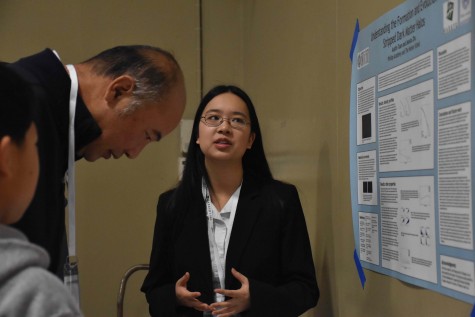 “Understanding the formation and evolution of stripped dark matter halos”
“Understanding the formation and evolution of stripped dark matter halos”
Jessica Zhu (12) worked with Austin Tuan (11) on researching dark matter halos, specifically studying the aspects of those halos while attempting to draw connections between different properties.
“My partner and I studied a bunch of data from simulations from dark matter halos and many properties including density, concentration and the shape of the halo,” she said. “Then, we found various relations between those properties, graphed them and then we drew equations.”
According to Jessica, a majority of her project included coding. Each week, using the Python programming language, she analyzed a large amount of data, in which she was required to pull out meaningful relationships.
The idea behind her research started at a summer program before her senior year.
“I applied for astrophysics because I really do enjoy physics,” she said. “Astrophysics was something related enough for me to have an interest in it, but it was never something I studied in school.”
Much of what she learned from her mentors is not only related to research but also communication skills.
“They taught me not only a lot about how to research but also how to your communicate ideas, which is equally as important in the scientific research community,” Jessica said. “Presenting makes it that you have to talk in a very clear and simple language, which really forces you to have a very deep understanding of your research as well.”
 “The Effect of age on human thinking processes”
“The Effect of age on human thinking processes”
Inspired by Daniel Kahneman’s “Thinking, Fast and Slow,” Shreyas Chandrashekaran (10) decided to pursue this newfound idea in his research project.
“[Kahneman] presented a different view of how we think, where the brain was split into two parts called system one and system two; system one is the fast thinking part of your brain and system two is the reasoning [part] and it takes longer for it to come up with answers,” Shreyas said. “So people use system one more than system two in day-to-day life because they take these shortcuts which makes it easier for them to think.”
Shreyas’ project dealt with inherent responses in three different age groups of children ages four to five, adolescents ages 13 to 18 and adults 18 and above.
“This is when people explain complex patterns or reasons for objects by using inherent features of those objects. Basically, people using this behavior show use of meta shotgun, which is a phenomenon where, when trying to explain complex patterns, people often answer an incorrect question, the one not being asked,” he said. “I found that children exhibited the characteristic a lot more than adults did.”
He believes that the significance of putting together a science research project is to benefit society as a whole.
“I really feel like every project here is important, and all of them have interesting locations for society as a whole,” he said. “I feel that it’s important to show those views to those around you, so you can widen the knowledge of these subjects.”
 “The role of VCAM 1+ sinusoidal endothelial cells in hematopoietic stem cell trafficking”
“The role of VCAM 1+ sinusoidal endothelial cells in hematopoietic stem cell trafficking”
When she was five years old, Natalie Simonian (12) started to developed an interest in stem cell research. Now, in her senior year, she researched stem cells in bone marrow during transplants.
“Although we have been doing these kinds of stem cell transparents for a really long time, scientists don’t understand how these stem cells behave out of the bone, which is what we’re trying to figure out,” Natalie said. “If we are able to figure it out, we’ll be able to design drugs that target that ,and we can give the donor that drug to pull out more stem cells, less bone marrow and less blood from them.”
Her research was divided into three main subsections, creating three different experiments going on simultaneously.
“[In] the first one we were creating a mouse model, so that meant bringing in a bunch of mice and isolating their DNA and trying to find what kind of genes they have; [the] second thing we were trying to do was to look at the bone marrow to see what type of cells were in there, how to distinguish those cells, and what they look like,” she said. “The third thing we did was we created that system in a dish to see how it was outside the bone. We put a layer of cells that represented the subcells that they come in and out of, and we made a layer on one side and saw how many made it through.”
Natalie also expressed her favorite part of the process.
“I’m obviously very passionate and interested in this project, so I really liked talking about it and also being able to show the research to other people.”
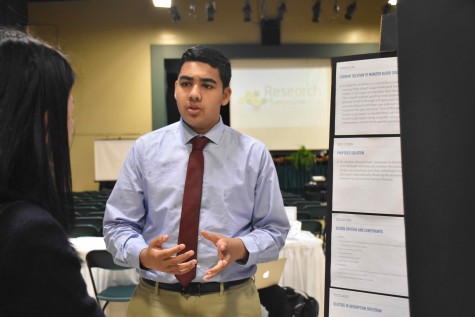 “Non-invasive glucose monitor”
“Non-invasive glucose monitor”
As Keval Shah (9) was greatly affected when his grandmother was diagnosed with diabetes, he wanted to find a way to help those living with this problem.
“As I grew up with her, she was constantly pricking herself, and I saw that her hand was constantly getting calluses,” he said. “Even though I can’t cure diabetes, I can probably have a lasting effect on people who have diabetes by having a non-evasive way of measuring glucose.”
Keval explains the processes and procedures he took to come to his result.
“The first thing I had to do was to find a way to solve this non-evasively, whether it was using x-rays or light; I found something that pumps glucose itself and I realized that it had a ten micrometer wavelength. If you emit light at ten micrometers, it will be able to go through the skin,” he said. “The information can be relayed through to the your smartphone; the app is to use the light to find out how much light is in your body.”
According to Keval, the most interesting part of his research experience was engineering and programming the system to relay the information.
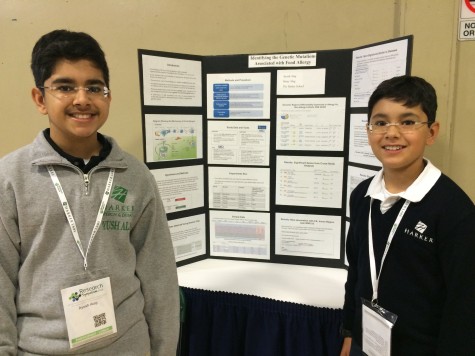 “Identifying the Genetic Mutations Associated with Food Allergy”
“Identifying the Genetic Mutations Associated with Food Allergy”
Siblings Ayush Alag (9) and Shray Alag (7) researched genetic mutations related to food allergy.
“Over 25 million people every year have problems with food allergy, so obviously it’s really a big problem and we want to stop [it],” Ayush said.
They used different tools to analyze and identify the genomic loci points that cause food allergy.
“We organized different experiments with different groups that we received from a public data set, and with these we ran several experiments using GEO2R tool,” Ayush said. “Then, we used another tool called the Illumina NextBio research tool, which gave us some data of the top genomic points that were associated with food allergy.”
Ayush and Shray were inspired to do this project because Ayush has a food allergy called Tonox.
Their project went beyond what was previously published research in providing insights to understanding the genomic basis of food allergy.
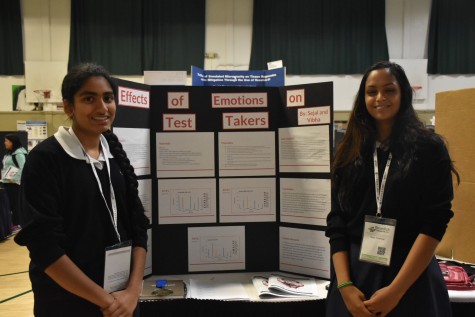 “Effects of Emotions on Test Takers”
“Effects of Emotions on Test Takers”
Sajel Krishnan (8) and Vibha Arramreddy (8) wondered which emotion would help a student do well on a test.
“What we did was in this test we took five emotions and a control group and decided to see which one would best benefit the student,” Sajel said.
Each student was required to either watch a video or do an exercise before taking the test with a certain emotion. The five different emotions were happy, sad, motivated, scared and relaxed. The test contained 10 questions from Math and English with an eight minute time limit.
“Our results that we found was that in the end when we compile all the data is that happy showed the highest grade,” Sajel said. “So basically if you enter a test smiling and laughing you should do well if you prepared the information.”
They have trouble mentally preparing for tests and figured that other students might share this problem. They were inspired to do this project to inform students about the best attitude to adapt to while preparing for a test.
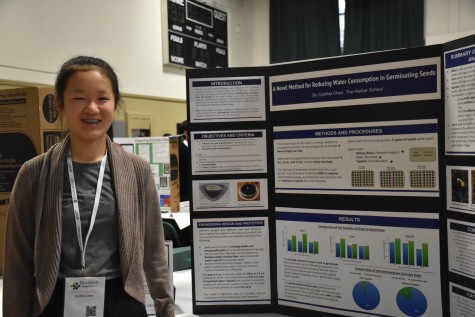 “A novel methods for reducing water consumption in germinating seeds”
“A novel methods for reducing water consumption in germinating seeds”
To help relieve the drought condition in California, Cynthia Chen (8) decided to do a project about finding the ways to reduce water use by farmers.
“My project aims to decrease water consumption in germinating seeds and basically helping the drought from that,” Cynthia said.
She developed a water retaining capsule made of a pod, a filter, and a layer of water crystals in between. This device provided the germinating seed with access to water.
“I’ve devised a capsule in order to get the objectives, then I tested in normal farming conditions but with different levels of water and I collected results,” Cynthia said.
She conducted the test on three different types of plants. She observed that the capsule helped the seeds germinate faster and also increased its chances of survival. This method demonstrated that it was effective in reducing water consumption during germination.
“What inspired me to do this project was that like all of my family and government too were bugging me to to take shorter showers to use less water in the home,” Cynthia said. “I did some research on what exactly causes the drought and I found out the most of the drought was caused by farming and not in household use.”